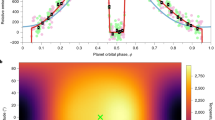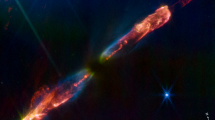Abstract
The presence of winds in Titan’s lower and middle atmosphere has been determined by a variety of techniques, including direct measurements from the Huygens Probe1 over 0–150 km; Doppler shifts of molecular spectral lines in the optical, thermal infrared and millimetre ranges2,3,4, which together have probed the ~100–450 km altitude range; inferences from the thermal field over 10–0.001 mbar (that is, ~100–500 km)5,6; and inferences from central flashes in stellar occultation curves7,8,9. These measurements predominantly indicated strong prograde winds, reaching maximum speeds of ~150–200 m s−1 in the upper stratosphere, with important latitudinal and seasonal variations. However, these observations provided incomplete atmospheric sounding; in particular, the wind regime in Titan’s upper mesosphere and thermosphere (500–1,200 km) has remained unconstrained so far. Here we report direct wind measurements based on Doppler shifts of six molecular species observed with the Atacama Large Millimeter/submillimeter Array (ALMA). We show that contrary to expectations, strong prograde winds extend up to the thermosphere, with the circulation progressively turning into an equatorial jet regime as the altitude increases, reaching ~340 m s−1 at 1,000 km. We suggest that these winds may represent the dynamical response of forcing by waves launched at upper stratospheric/mesospheric levels and/or of magnetospheric–ionospheric interaction. We also demonstrate that the distribution of the hydrogen isocyanide (HNC) molecule is restricted to Titan’s thermosphere above ~870 km altitude.
This is a preview of subscription content, access via your institution
Access options
Access Nature and 54 other Nature Portfolio journals
Get Nature+, our best-value online-access subscription
$29.99 / 30 days
cancel any time
Subscribe to this journal
Receive 12 digital issues and online access to articles
$119.00 per year
only $9.92 per issue
Buy this article
- Purchase on Springer Link
- Instant access to full article PDF
Prices may be subject to local taxes which are calculated during checkout



Similar content being viewed by others
Data availability
The data that support the plots within this paper and other findings of this study are available from the ALMA archive (http://almascience.nrao.edu/aq/; Cycle 3 programme 2015.1.01023.S (PI M. Gurwell)) and from the corresponding author upon reasonable request.
Code availability
Novel methods developed for this research and not available from previous studies are available from the corresponding author upon reasonable request.
References
Folkner, W. M. et al. Winds on Titan from ground-based tracking of the Huygens probe. J. Geophys. Res. 111, E07S02 (2006).
Luz, D. et al. Characterization of the zonal winds in Titan’s stratosphere of Titan with UVES. 2. Observations coordinated with the Huygens Probe entry. J. Geophys. Res. 111, E08S90 (2006).
Kostiuk, T. et al. High spectral resolution infrared studies of Titan: winds, temperature and composition. Planet. Space Sci. 58, 1715–1723 (2010).
Moreno, R., Marten, A. & Hidayat, T. Interferometric measurements of zonal winds on Titan. Astron. Astrophys. 437, 319–328 (2005).
Achterberg, R. K. et al. Titan’s middle atmospheric temperatures and dynamics observed by the Cassini Composite Infrared Spectrometer. Icarus 194, 263–277 (2008).
Achterberg, R. K. et al. Temporal variations of Titan’s middle atmospheric temperatures from 2004 to 2009 observed by the Cassini/CIRS. Icarus 211, 686–698 (2011).
Hubbard, W. B. et al. The occultation of 28Sgr by Titan. Astron. Astrophys. 269, 541–563 (2005).
Bouchez, A. H. Seasonal Trends in Titan’s Atmosphere: Haze, Winds, and Clouds. PhD thesis, California Institute of Technology (2004).
Sicardy, B. et al. The two Titan stellar occultations of 14 November 2003. J. Geophys. Res. 111, E11S91 (2006).
Cordiner, M. et al. ALMA measurements of the HNC and HC3N distributions in Titan’s atmosphere. Astrophys. J. Lett. 795, L30 (2014).
Lai, J. C.-Y. et al. Mapping vinyl cyanide and other nitriles in Titan’s atmosphere using ALMA. Astron. J. 154, L206 (2017).
Vinatier, S. et al. Vertical abundance profiles of hydrocarbons in Titan’s atmosphere at 15° S and 80° N retrieved from Cassini/CIRS spectra. Icarus 188, 120–138 (2007).
Teanby, N. et al. Vertical profiles of HCN, HC3N and C2H2 in Titan’s atmosphere derived from Cassini/CIRS data. Icarus 186, 364–384 (2007).
Dobrijevic, M., Loison, J.-C., Hickson, K. M. & Gronoff, G. 1D-coupled photochemical model of neutrals, cations and anions in the atmosphere of Titan. Icarus 268, 313–339 (2016).
Crary, F. J. et al. Heavy ions, temperatures and winds in Titan’s ionosphere: combined Cassini CAPS and INMS observations. Planet. Space Sci. 57, 1847–1856 (2009).
Cravens, T. et al. Dynamical and magnetic field time constants for Titan’s ionosphere: empirical estimates and comparisons with Venus. J. Geophys. Res. 115, A08319 (2010).
Rishbeth, H., Yelle, R. V. & Mendillo, M. Dynamics of Titan’s thermosphere. Planet. Space Sci. 48, 51–58 (2000).
Müller-Wodarg, I. C. F., Yelle, R. V., Mendillo, M. & Aylward, A. D. On the global distribution of neutral gases in Titan’s upper atmosphere and its effect on the thermal structure. J. Geophys. Res. 108, 1453 (2003).
Müller-Wodarg, I. C. F., Yelle, R. V., Cui, J. & Waite, J. H. Horizontal structures and dynamics of Titan’s thermosphere. J. Geophys. Res. 113, E10005 (2008).
Snowden, D. et al. The thermal structure of Titan’s upper atmosphere. I: Temperature profiles from Cassini INMS observations. Icarus 226, 552–582 (2013).
Westlake, J. H. et al. Titan’s thermospheric response to various plasma environments. J. Geophys. Res. 116, A03318 (2011).
Snowden, D. & Yelle, R. V. The thermal structure of Titan’s upper atmosphere. II: Energetics. Icarus 228, 64–77 (2014).
Ågren, K. et al. On the ionospheric structure of Titan. Planet. Space Sci. 57, 1821–1827 (2009).
Ulusen, D. et al. Comparisons of Cassini flybys of the Titan magnetospheric interaction with an MHD model: evidence for organized behavior at high altitudes. Icarus 217, 43–54 (2012).
Ågren, K. et al. Detection of currents and associated electric fields in Titan’s ionosphere from Cassini data. J. Geophys. Res. 116, A04313 (2011).
Aboudan, A., Colombatti, G., Ferri, F. & Angrilli, F. Huygens probe entry trajectory and attitude estimated simultaneously with Titan’s atmospheric structure by Kalman filtering. Planet. Space Sci. 56, 573–585 (2008).
Müller-Wodarg, I. C. F., Yelle, R. V., Borggren, N. & Waite, J. H. Waves and horizontal structures and dynamics of Titan’s thermosphere. J. Geophys. Res. 111, A12, id A12315 (2006).
Strobel, D. F. Gravitational tidal waves in Titan’s upper atmosphere. Icarus 182, 251–258 (2006).
Bézard, B., Vinatier, S. & Achterberg, R. Seasonal radiative transfer modeling of Titan’s stratospheric temperatures at low latitudes. Icarus 302, 437–450 (2018).
Fels, S. B. & Lindzen, R. S. The interaction of thermally excited gravity waves with mean flows. Geophys. Fluid Dyn. 6, 149–191 (1974).
Zhu, X. Maintenance of equatorial superrotation in the atmosphere of Venus and Titan. Planet. Space Sci. 54, 761–773 (2006).
Hoshino, N., Fujiwara, H., Takagi, M. & Kasaba, Y. Effects of gravity waves on the day-night difference of the general circulation in the Venusian lower thermosphere. J. Geophys. Res. Planets 118, 2004–2015 (2013).
Thelen, A. et al. Abundance measurements of Titan’s stratospheric HCN, HC3N, C3H4 and CH3CN from ALMA observations. Icarus 319, 417–432 (2019).
Moreno, R. et al. First detection of hydrogen isocyanide (HNC) in Titan’s atmosphere. Astron. Astrophys. 536, L12 (2011).
Lellouch, E. et al. Detection of CO and HCN in Pluto’s atmosphere with ALMA. Icarus 286, 289–307 (2017).
Anderson, C. M. & Samuelson, R. E. Titan’s aerosol and stratospheric ice opacities between 18 and 500 μm: vertical and spectral characteristics from Cassini CIRS. Icarus 212, 762–778 (2011).
Conrath, B. J., Gierasch, P. J. & Ustinov, E. A. Thermal structure and para hydrogen fraction on the outer planets from Voyager IRIS measurements. Icarus 135, 501–517 (1998).
Rodgers, C. D Inverse Methods for Atmospheric Sounding: Theory and Practice (World Scientific, 2000).
Marten, A., Hidayat, T., Biraud, Y. & Moreno, R. New millimeter heterodyne observations of Titan: vertical distributions of nitriles: HCN, HC3N, CH3CN, and the isotopic ratio 15N/14N in its atmosphere. Icarus 158, 532–544 (2002).
Thelen, A. E. et al. Spatial variations in Titan’s atmospheric temperature: ALMA and Cassini comparisons from 2012 to 2015. Icarus 307, 380–390 (2018).
Cui, J., Cao, Y.-T., Lavvas, P. P. & Koskinen, T. T. The variability of HCN in Titan’s upper atmosphere as implied by the Cassini Ion-Neutral Mass Spectrometer measurements. Astrophys. J. Lett. 826, L5 (2016).
Koskinen, T. T. et al. The mesosphere and lower thermosphere of Titan revealed by Cassini/UVIS stellar occultations. Icarus 207, 511–534 (2011).
Yelle, R. V. Non-LTE models of Titan’s upper atmosphere. Astrophys. J. 383, 380–400 (1991).
Molter, E. M. et al. ALMA observations of HCN and its isotopologues on Titan. Astron. J. 152, 42 (2016).
Vinatier, S. et al. Seasonal variations in Titan’s stratosphere observed with Cassini/CIRS during northern spring. In American Astronomical Society DPS Meeting 49 304.03 (AAS, 2017).
Cui, J. et al. Analysis of Titan’s neutral upper atmosphere from Cassini ion neutral mass spectrometer measurements. Icarus 200, 581–615 (2009).
Vinatier, S. et al. Analysis of Cassini/CIRS limb spectra of Titan acquired during the nominal mission. I. Hydrocarbons, nitriles and CO2 vertical mixing ratio profiles. Icarus 205, 559–570 (2010).
Lellouch, E., Goldstein, J. J., Rosenqvist, J., Bougher, S. W. & Paubert, G. Global circulation, thermal structure, and carbon monoxide distribution in Venus’ mesosphere in 1991. Icarus 110, 315–339 (1994).
Acknowledgements
E.L., R.M. and S.V. acknowledge support from the Programme National de Planétologie (PNP-INSU). This paper makes use of the following ALMA data: ADS/JAO.ALMA#2015.1.1023.S. ALMA is a partnership of ESO (representing its member states), NSF (USA) and NINS (Japan), together with NRC (Canada), MOST and ASIAA (Taiwan), and KASI (Republic of Korea), in cooperation with the Republic of Chile. The Joint ALMA Observatory is operated by ESO, AUI/NRAO and NAOJ. The paper is dedicated to the memory of Daniel Lellouch, deceased on 13 February 2019.
Author information
Authors and Affiliations
Contributions
M.A.G. wrote the ALMA proposal. M.A.G. and R.M. reduced the ALMA data. E.L. analysed and modelled the data (with contribution from R.M.) and wrote most of the manuscript. S.V. provided initial thermal profiles as well as insight in the general science context. D.F.S. led the interpretative part. All authors discussed the manuscript.
Corresponding author
Ethics declarations
Competing interests
The authors declare no competing interests.
Additional information
Journal peer review information: Nature Astronomy thanks Agustín Sanchez-Lavega and Jan-Erik Wahlund for their contribution to the peer review of this work.
Publisher’s note: Springer Nature remains neutral with regard to jurisdictional claims in published maps and institutional affiliations.
Supplementary information
Supplementary Information
Supplementary text, Supplementary Table 1, Supplementary Figures 1–7.
Rights and permissions
About this article
Cite this article
Lellouch, E., Gurwell, M.A., Moreno, R. et al. An intense thermospheric jet on Titan. Nat Astron 3, 614–619 (2019). https://doi.org/10.1038/s41550-019-0749-4
Received:
Accepted:
Published:
Issue Date:
DOI: https://doi.org/10.1038/s41550-019-0749-4
This article is cited by
-
Dynamics and clouds in planetary atmospheres from telescopic observations
The Astronomy and Astrophysics Review (2023)
-
Science goals and new mission concepts for future exploration of Titan’s atmosphere, geology and habitability: titan POlar scout/orbitEr and in situ lake lander and DrONe explorer (POSEIDON)
Experimental Astronomy (2022)
-
Wind, rain and methane on Titan
Nature Reviews Physics (2019)



